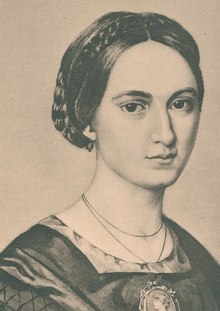Milica Stojadinović-Srpkinja
Milica Stojadinović-Srpkinja | |
|---|---|
 Portrait of poet Milica Stojadinović-Srpkinja | |
| Born | 6 July 1828 |
| Died | 25 July 1878 (aged 50)[1] |
| Occupation | Poet |
Milica Stojadinovic-Srpkinja (Serbian Cyrillic: Милица Стојадиновић Српкиња, pronounced [mîlitsa stɔjadǐːnɔv̞itɕ sr̩̂pkiɲa]) (1828–1878) was a Serbian poet, sometimes called "the greatest female Serbian poet of the 19th century".
Career
As her fame spread beyond the confines of Serbian culture of the Austrian Empire, Prince Mihailo Obrenović would invite her to court when she came to Belgrade and Vienna-based anthropologist and poet Johann Gabriel Seidl devoted a poem to her.
She corresponded extensively with writers Đorđe Rajković (1825–1886), Ljubomir Nenadović, Vuk Stefanović Karadžić and his daughter Wilhelmine/Mina, Božena Němcová, and with Ludwig August von Frankl. In 1891 an almanach Die Dioskuren was issued in Vienna by Ludwig von Frankl with a collection of letters written by Milica Stojadinović.
Reception

Her work, though, has been mostly out of the public eye and almost forgotten except by literary experts for most of the 20th century, first during fin-de-siècle modernist poeticism as an outdated poetic form of pre-1870s, and later, under Communist rule as an unacceptable expression of patriotism for only one of the six nations of Yugoslavia (namely: Serbian).
After Josip Broz Tito's death the awareness of her work was revived, and in the last quarter of a century a four-day poetry memorial is convened annually in Novi Sad in her honour, where a poetry prize bearing her name is awarded to prominent poets from Serbia.
Biljana Dojčinović has written on the role of Stojadinović-Srpkinja in the development of women's writing in Serbia, through a feminist framework.[2]
Text is available under the CC BY-SA 4.0 license; additional terms may apply.
Images, videos and audio are available under their respective licenses.

